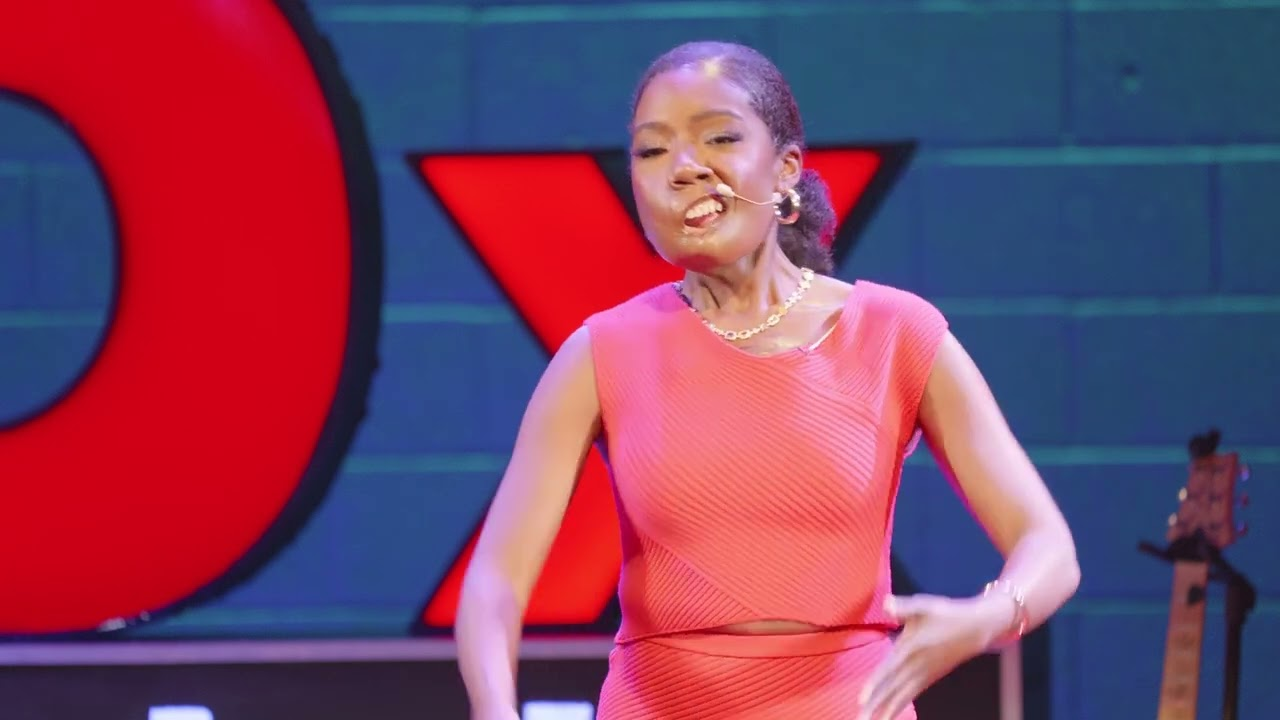The video features an individual born with a rare craniofacial condition called arterial venous malcranation, which caused significant disfigurement and communication challenges. This condition led to the loss of typical verbal and non-verbal communication methods due to facial paralysis and required nearly fifty surgeries for management. Despite this, the speaker shares the creative adaptations developed, such as new ways to eat and drink, highlighting the critical role of the face in human interaction and communication.
The narrative underscores the misconceptions and stigmas faced by people with facial disfigurements, touching on stereotypes that regard such individuals as untrustworthy or unhappy. Through personal experiences, the speaker addresses how both media representation and societal perception negatively impact those with facial differences. The importance of understanding nonverbal communication and recognizing facial expressions, which play a significant role in how we perceive emotions, is emphasized.
Main takeaways from the video:
Please remember to turn on the CC button to view the subtitles.
Key Vocabularies and Common Phrases:
1. craniofacial [ˌkreɪnioʊˈfeɪʃəl] - (adjective) - Relating to the bones of the skull and face. - Synonyms: (skull-facial, skull-front)
I was born with a rare craniofacial condition called arterial venous malcranation.
2. malformation [ˌmælfɔːrˈmeɪʃən] - (noun) - A deformity or an abnormally formed part of the body. - Synonyms: (deformity, anomaly, disfigurement)
It's a long word that means my arteries and my veins were connected incorrectly.
3. implicate [ˈɪmplɪˌkeɪt] - (verb) - To involve or indicate someone in something, especially suggesting involvement in a negative or incriminating situation. - Synonyms: (involve, suggest, hint)
Few of you will understand the implications of this firsthand.
4. nonverbal [ˌnɒnˈvɜːbəl] - (adjective) - Not involving or relying on the use of spoken language. - Synonyms: (unspoken, silent, non-linguistic)
The avenues of verbal and nonverbal communication available to someone with a normal face were stripped from me
5. contempt [kənˈtɛmpt] - (noun) - The feeling that a person or a thing is beneath consideration or worthless. - Synonyms: (disdain, scorn, derision)
Paul Eaknin, a pioneer in the study of ignition, found evidence for seven facial expressions that are now considered universal: Happiness and sadness, anger, contempt, disgust, fear and surprise.
6. disfigurement [dɪsˈfɪɡərmənt] - (noun) - The action of spoiling the appearance or shape of something. - Synonyms: (deformity, mutilation, mar)
And people with severe disguise have faces that are often misread.
7. stigma [ˈstɪɡmə] - (noun) - A mark of disgrace associated with a particular circumstance, quality, or person. - Synonyms: (shame, disgrace, reproach)
The stereotypes and the social stigmas that render us incapable of communicating and connecting.
8. grit [ɡrɪt] - (noun) - Courage and resolve; strength of character. - Synonyms: (fortitude, perseverance, tenacity)
Looking back, honing two qualities made all the difference. grit and grace.
9. grace [ɡreɪs] - (noun) - Simple elegance or refinement of movement. Also, it can mean courteous goodwill. - Synonyms: (elegance, poise, refinement)
And grace. grace is undeserved. Vagar in our case, blessings that would come through a devastating setback routine procedure my 22nd surgery was supposed to be a routine procedure.
10. nonverbal Communication [ˌnɒnˈvɜrbəl kəˌmjunɪˈkeɪʃən] - (noun) - Communication methods that do not involve words, such as gestures, facial expressions, and body language. - Synonyms: (body language, sign language, silent communication)
The avenues of verbal and nonverbal communication available to someone with a normal face were stripped from me
The face of disfigurement - Dr. Jasmine "Jaz" Gray - TEDxMemphis
Losing your capacity for typical expressions of communication is an unconventional path to eventually finding your I was born with a rare craniofacial condition called arterial venous malcranation. It's a long word that means my arteries and my veins were connected incorrectly. Too much blood rushes through way too quickly, destroying everything in its path. Over time, my face began to morph until I was unrecognizable to others and even to myself.
The avenues of verbal and nonverbal communication available to someone with a normal face were stripped from me. Body card not body card. Sections of not tongue, not teeth, not tissues, not lips, not chin, not jawbone. Gone. Eventually, the right side of my face would be paralyzed forever. I have had nearly 50 surgeries in 36 years to control my condition and construct this face.
Those of us whose faces have been disfigured, we cannot take for granted the power of the face or human being. We grieve and speak. We see, hear, taste and smile all through our faces. Few of you will understand the implications of this firsthand. What it's like to spend years learning how to pronounce words again. Learning new ways to drink with lips that can no longer clasp onto the outside of a cup, or learning new ways to eat, like smashing a caramel apple sucker with a hanger just for a chance to enjoy the sweet bits and teases. We do get creative.
The faith is the center of our capacity to communicate. While the focus is often on verbal messages, studies show that anywhere from half to a whopping 93% of all of our communication is actually non variable. In fact, the human face, with its 43 muscles, can make up to 10,000 excretions. And while many of our facial expressions vary depending on culture, Paul Eaknin, a pioneer in the study of ignition, found evidence for seven facial expressions that are now considered universal. Happiness and sadness, anger, contempt, disgust, fear and surprise.
For example, you may see someone's eyes widened and their eyebrows raised and they negatively put their hand over their chest, and you could interpret that they are surprised. Or you may see someone smile and you would interpret that they are yes, haggie. The face is a critical component of what it means to be human, and the face is as dynamic as we are. Neuroscience researcher Eliza Stellino and her colleagues explained that the human face is never static. It's always acting and reacting based on internal and external stimuli. And our facial movements don't happen in isolation.
They're coordinated with the muscles throughout our entire body, all working together to create what we perceive as an emotional Experience the face can both support and hinder our capacity for human connection. And people with severe disguise have faces that are often misread. Psychology researcher Francisca Hertung and her colleagues discovered there is a disfigured it's bad stereotype. People with facial differences are often perceived as deemed untrustworthy, unintelligent and unhappy. The media also play a role as this cultural force of mass communication. They take these misperceptions of us and they broadcast them to the rest of the world, namely that scarred faces are evil and scary.
Now, if the story ended right here, the narrative will simply be that beyond our language facial features, it's the stereotypes and the social stigmas that render us incapable of communicating and connecting. The end Thankfully, Grandma, I have learned Thankfully, I have learned that navigating communication barriers was the key to me unlocking thy voice. Looking back, honing two qualities made all the difference. grit and grace. Amen. grit is the active endurance we use to face our circumstances head on. And grace. grace is undeserved.
Vagar in our case, blessings that would come through a devastating setback routine procedure my 22nd surgery was supposed to be a routine procedure. When I woke up, I had been moved from the recovery unit to a private room. The lights were dimmed and the curtains were closed that I could just make out none other. She was standing up, but her knees were close to leveling in shock. As I stared into her eyes, every ounce of what she was feeling showed on her face. Non verbal communication in action. The look was a mixture of confusion and fear, of utter disbelief and defeat. The look said, lord, how could this happen to my child? I knew something was wrong.
Nana tilted her head and she began to move her hand in a circular motion along her right cheek. All of this got infected, Jay. It had to be removed. It's gone. It took all the grit I had not to flood the room with my tears. Later, my doctor would inform my family that my facial nerves, the major nerve sending signals that control facial movement and expression, had been cut. I would never be able to fully smile again in an instant. Now those versatile communication tools. My fate had been destroyed.
After years of trying to look normal, having surgery after surgery after surgery, waving a world of silent stares and awkward encounters of laughing teenagers in laws and haunting children in restaurants, years of overhearing what's going on with her face, I would slowly die to the desire for a face that communicates normally. A divine act of grace. Yes, grace, I would start to wear thy hair that would somehow nay me hold my head higher. I would dare to show off the scars that now cover my body. I would take a stage like this one. Using this face. As incorrect as it is to connect with all of you, those of us with facial differences, we have opportunities for communication and connection etched into the very crevices of our faces.
They are opportunities for you to draw closer rather than push away. You can train yourself to look at others, no matter what appearances may be, communicating or miscommunicating, and you can choose to see them as a soul with a story. So the next time you see someone who looks different, instead of prioritizing your own curiosity, like asking them what happened, start by asking their name. Remembering that those of us with facial differences are yearning for genuine connection, we are striving to live with grit and grace through every experience that we face.
Inspiration, Science, Technology, Craniofacial, Nonverbal Communication, Stigmas, Tedx Talks


